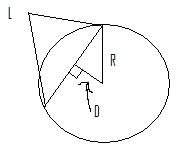| Line 1: | Line 1: | ||
[[Image:hw5number3SA_ECE302Fall2008sanghavi.jpg]] | [[Image:hw5number3SA_ECE302Fall2008sanghavi.jpg]] | ||
| − | I began the same way as Beau with the drawing of a circle. Then i had drawn a chord from one side to the other. I then drew a line for the radius to one end of the chorde. The distance D is the line intersecting the chord at a 90 degree angle. Then you can use Pythagorean thm to find the distance L. Then to find the PDF of the whole chord, i just used the formula with the integral and used the parameters or D and fx(x) as 2 times the L. | + | I began the same way as Beau with the drawing of a circle. Then i had drawn a chord from one side to the other. I then drew a line for the radius to one end of the chorde. The distance D is the line intersecting the chord at a 90 degree angle. Then you can use Pythagorean thm to find the distance L/2. Then to find the PDF of the whole chord, i just used the formula with the integral and used the parameters or D and fx(x) as 2 times the L. |
Revision as of 12:41, 6 October 2008
I began the same way as Beau with the drawing of a circle. Then i had drawn a chord from one side to the other. I then drew a line for the radius to one end of the chorde. The distance D is the line intersecting the chord at a 90 degree angle. Then you can use Pythagorean thm to find the distance L/2. Then to find the PDF of the whole chord, i just used the formula with the integral and used the parameters or D and fx(x) as 2 times the L.


